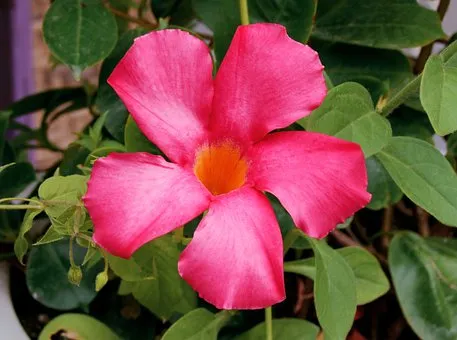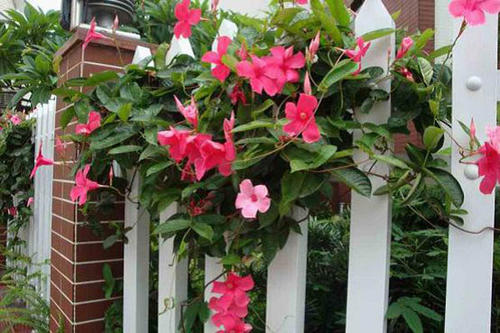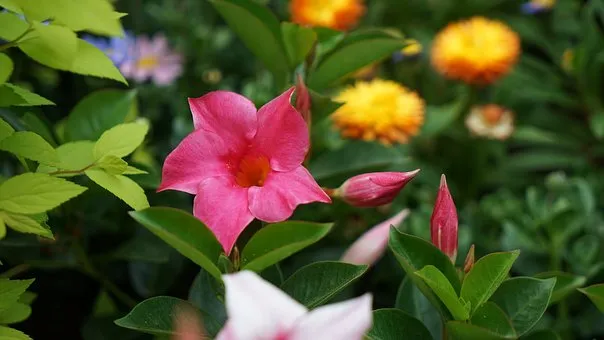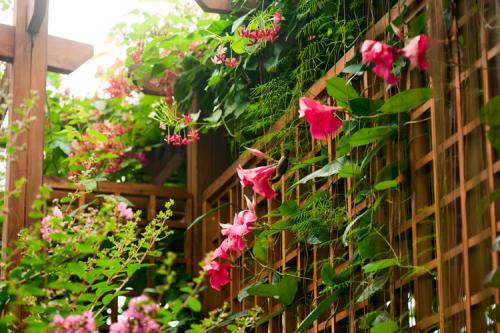How to Care for Brazilian Jasmine Plant (Mandevilla Sanderi)
Written by Maggie
Apr 08 2023

Brazilian Jasmine Plant (Mandevilla Sanderi) is a new type of vine, like morning glory, fragrant rattan in bloom, often presents flowers more than leaves of the grand occasion, the breeze hits, bursts of tangy fragrance makes people relaxed and happy. How to care for Brazilian jasmine leaves falling or buds falling? Today we'll talk about some Brazilian jasmine caring tips.
Brazilian jasmine will grow at its fastest under conditions of regular light feedings, bright light without afternoon sun, consistently moist soil, and extremely high humidity and temperature levels.

Brazilian Jasmine Care Quick Info
| Botanical/Scientific Name | Mandevilla Sanderi |
| Common Name | Brazilian Jasmine |
| When to Grow/Bloom/Harvest | Grow in the spring/Bloom from early July to mid-September |
| Uses | Liver disease (hepatitis) |
| Origin | State of Rio de Janeiro in Brazil |
| Light Care | Bright indirect light |
| Soil Care | Moist and well-drained |
| Temperature Care | Between 60 to 75 degrees Fahrenheit |
| Humidity Care | Warm and humid |
| Watering | Be watered once a week |
| Pruning Care | Do hard pruning immediately after blooming |
| Fertilizer Care | Regular applications |
| Propagation | Cuttings |
| Toxic | Poisonous to dogs |
| Flower Color | Red |
When does Brazilian Jasmine Bloom & Harvest
The flowering period of Brasilian jasmine is relatively long, and it blooms almost half a year. The flowering period of Brasilian jasmine is mainly concentrated in summer and autumn. When brazilian jasmine blooms, the Corolla is funnel-shaped, and the flower colors are red, peach, orange and pink. Brasilian Jasmine has bright colors and is more ornamental. If you want Brasilian jasmine to blossom longer and more beautiful, you should pay attention to the usual maintenance and management. To make it more exposed to the sun and good temperature control, we also need to ensure sufficient fertilizer and water, so that it can blossom better in this environment.Brazilian Jasmine Care in Detail
Watering
The climate is different throughout the year, and we water Brazilian Jasmine at different frequencies. We can water a small amount in early spring. When the temperature rises, we should water it in time, and water it every three days or so. The evaporation rate of water is fast in summer. We can water it every 1-2 days and spray water to increase the humidity. It should also be watered in time just in autumn. As the temperature drops, it can be watered once every 4-5 days. In winter, you can water Brazilian Jasmine once a week and control the watering frequency,Soil
The soil for breeding Brazilian Jasmine can be mixed with humus and coarse sand. Such soil has certain air permeability, sufficient nutrients and not poor drainage capacity, which can make Brazilian Jasmine grow better and maintain a good growth state. If Brazilian jasmine is planted in a pot, we can also add an appropriate amount of organic fertilizer to the soil.Light
We'd better keep Brazilian Jasmine in a place with as much light as possible and keep more than 6 hours of direct light every day. It's best to shelter from wind and rain under the balcony. Good ventilation of the environment is very important. We should avoid keeping Brazilian Jasmine in an air tight environment, which is suitable for cultivation as a climbing plant on the balcony.Temperature
Brasilian jasmine is a tropical positive plant, which likes high temperature and light and can tolerate semi-shade. Brazilian jasmine is suitable to grow in an environment of 2 ~ 30 ℃. When the temperature is lower than 10 ℃, the plant is in a semi deciduous state. When the temperature is lower than 5 ℃, it will be frostbitten and die at 0 ℃. During the growth period, we should give Brazilian Jasmine sufficient light to increase the flowering amount of Brazilian jasmine.Humidity
Brazilian Jasmine has high requirements for water. If it is too wet, the roots will suffer and even other diseases; If it is too dry, it will affect the absorption of fertilizer. We can properly water Brazilian Jasmine more in summer and less in winter, because Brazilian Jasmine requires air humidity between 70% - 80%.Fertilizer
Brazilian Jasmine has a high demand for fertilizer, especially before flowering. From April, it is necessary to supplement thin organic fertilizer once or twice a week. It is best to use concentrated organic liquid fertilizer. Fertilization will be stopped in September. After it cools in autumn, avoid applying fertilizer to Brazilian jasmine.
Pruning
Brasilian Jasmine needs pruning during its growth. We can remove the top bud of Brasilian jasmine and remove the branches at the top of Brasilian jasmine, so as to promote the growth of more branches and increase the amount of flowering. Brazilian Jasmine grows vigorously and its branches grow disorderly. You can thinly cut the plants, cut off the Yellow branches and leaves, and remove the thin and weak branches, dead branches, old branches, inner bore branches and Cross branches. After the flowering period, we can trim the remaining flowers, cut short the flower branches, and cut off the withered flower branches.Repotting
The potted Brazilian Jasmine needs to change the pot and soil once after 1-2 years. When changing the pot soil, we can properly trim the roots and cut off the old roots and rotten roots. The over-dense branches on the plant can also be properly pruned, and then prepare new soil for washing and planting.Brasilian Jasmine can change pots either in spring or after the flowers wither in autumn. Special attention should be paid to removing the pot. We can first remove the shelf or the hook on the edge of the pot, and then take the plant out of the pot, properly trim the roots and cut off the unhealthy roots. We should select the appropriate flower pot, fill it with loose sand, and then plant Brazilian jasmine, pour water into it, put it in astigmatism, etc.
Pest & Disease Control
Brazilian jasmine is generally less. The common disease of Brazilian jasmine is mainly root rot. Pests include whitefly and so on.- Root rot: the occurrence of root rot is mostly caused by too wet soil, poor drainage or too low temperature. After the plant was infected, the leaves withered quickly, then the roots rotted and the plant died slowly. We can choose a well drained substrate for Brazilian jasmine, water it alternately dry and wet, and place the plants in a bright and hot place.
- Whitefly: we can use 1000 times of 10% chlorpyrifos EC to deal with whitefly, or 4000 times of 20% kangmnduonong solvent.
Brazilian Jasmine Propagation
Propagate Brazilian Jasmine from Cutting
Brazilian jasmine propagation from cutting is implemented in spring and autumn. We can cut 1-2-year-old branches with 2-3 nodes and multiple leaves. Select annual branches from Brazilian Jasmine plants, remove the leaves at the base, keep the leaves at the top, dip them in root water and dry them next to them. Moisturizing and heat preservation, hair roots after about 3 weeks. When the temperature is kept at about 20-25 ℃, it can be conducive to rooting under appropriate environment.How to Propagate Brazilian Jasmine from Division
Brazilian Jasmine can reproduce by means of ramets, which can be carried out before germination in early spring in combination with pot change. We can choose a cluster plant with vigorous growth, take Brazilian Jasmine out of the flower pot, prepare a sharp knife, separate the sprouts from the branches and the base, and remove the attached old soil. Prepare and prepare suitable soil, put the soil into the flower pot, and plant Brazilian Jasmine in the soil.Brazilian Jasmine Propagation from Layering
We can also use brazilian jasmine propagation from layering. We can choose to grow robust plants and select annual robust vine branches from above. The base of the branches is broken about 1-2 cm with a sharp knife. Press the wound of the branch into the soil, cover it with soil and compact it. A brick can be covered here to ensure compaction. Keep the temperature and humidity well. For about three months, Brazilian Jasmine can take root at the wound. At this time, the junction can be cut off, so that new plants can be cultivated.
Brazilian Jasmine Benefits
1. Ornamental value
The value of Brazilian jasmine is mainly ornamental, with luxuriant branches and leaves and many flowers. Brazilian jasmine is a climbing vine plant. It can be trimmed into a sphere for people to watch when it is cultured indoors. It is best to have high decoration and ornamental value in the roof and small courtyard.2. Purification value
Brazilian Jasmine also has high air purification value. If it is placed in the indoor environment, it can absorb formaldehyde, benzene and other toxic substances, and even dust in the air, so as to achieve the effect of air purification. It also has adsorption function for sulfur dioxide in the air, which is very suitable for indoor propagation.3. Greening value
Brazilian Jasmine planted in the courtyard also has high greening value. The green leaves can achieve the role of greening, and placing them indoors can also alleviate eye fatigue, improve vision and relax mood, which is very beneficial to human physical and mental health.4. Use value
Brazilian Jasmine also has high use value. We can extract essential oil from the plant. Whenever the plant blooms, the flower fragrance overflows. It is very rich. A large amount of volatile oil can be extracted from its flowers, which is also a natural harmless essential oil. Therefore, Brazilian Jasmine has high use value in addition to its ornamental and purification value.Brazilian Jasmine Care for Leaves Yellowing & Falling
The yellow shedding of Brazilian jasmine leaves may be a dry yellow condition caused by lack of water. In this case, water must be replenished as soon as possible to make the soil moist. In the growth season, regular watering, and water can not appear. It may also be improper fertilization, the high concentration of fertilizer applied, too much fertilizer will produce fertilizer harm, leaves will fall. Water should be poured as soon as possible to rinse off fertilizer and help recovery. If the fertilizer damage is serious, directly remove the basin for soil. The following are details of Brazilian jasmine care for leaves yellowing and falling.
If there are yellow spots on the Brazilian jasmine leaves, it is still too late to detect them and take measures. Move to a cool and well-ventilated location as soon as possible. If the soil is too wet and wilting, you can take off the pot and blow dry the soil with a fan.
Perhaps because in the south, muggy and rainy season should be controlled by watering, such as basin soil surface dry again watering. Still have a bit is to want to strengthen ventilation, often open a window to ventilate or it is to put it in outdoor half shade place to conserve, spray fungicide to prevent fungal sex disease regularly.
Too much fat yellow fertilisation can cause a fertiliser destroying phenomenon, leading to a sweet cane yellow smell. When new Brazilian jasmine leaves are dry on brown, old leaves fall off brown and uneven. It is recommended to stop fertilizing, fertilizing, washing with water when necessary, and for lack of fertilizer, young leaves thin pale yellow, old leaves yellow, thin fat is often applied at this time of attention, and to give it iron.
Excessive light can cause burns to turn yellow. The tips and edges of the leaves can become dry, and they can show yellow spots in the morning sun. I suggest you move it to a cooler place.
Brazilian Jasmine Care for Buds Falling
The buds are falling out in Brazilian Jasmine, which may be caused by lack of light. Without enough light, the Brazilian Jasmine cannot carry out photosynthesis. When we care for Brazilian Jasmine, if there is insufficient water, the buds of Brazilian jasmine will dry up and fall off at the later stage. If the fertilizer is insufficient, the Brazilian jasmine will lack nutrition, and the flower buds will fall off. Low temperature will cause poor growth of the Brazilian jasmine, and the flower buds will fall off. The following are details of Brazilian Jasmine care for buds falling.
The buds of brazilian jasmine plant fall off, probably due to lack of light. Brazilian jasmine is fond of light and needs sufficient light during its growth to promote the release of flowers. Brazilian Jasmine has been kept indoors for long-term maintenance, but the indoor light is insufficient. Brazilian jasmine is unable to photosynthesize and accumulate nutrients, and the buds gradually fall off in later stages.
Brazilian Jasmine has a high demand for water in the early flowering period, and the lack of water will also cause the buds to drop. When we care for Brazilian Jasmine, if Brazilian Jasmine is not watered for a long time or supplemented with water in a dry climate, the buds of Brazilian Jasmine will fall off in the later period. Excessive watering of Brazilian jasmine during curing can also cause the buds to fall off.
Before flowering, the buds fall off due to lack of fertilizer. Brazilian jasmine needs a proper amount of fertilizer in flowering, and enough fertilizer can promote the growth of flowers. When we care for Brazilian jasmine, if the Brazilian Jasmine is fertilized in time, the Brazilian Jasmine lacks fertilizer. Under the condition of insufficient nutrition, a large number of flower buds will fall off in the later period, which will affect the opening of flowers.
When we care for Brazilian jasmine plant, the temperature is low, and will also make the bud fall off. During curing, Brazilian jasmine can grow normally only when the temperature is between 20 and 30 degrees. Brazilian jasmine can suffer from poor growth if the temperature is too low, below 20 degrees Celsius. Brazilian jasmine does not grow normally, and leaves wither and buds fall off at later stages. (Find more Vine Plants Indoor here.)

Read Next:
Brazilian Jasmine Plant Propagation
20 Popular Vine Plants Indoor To Grow
Top 20 Climbing Plants with Flowers for Your Garden
Common Questions About Brazilian Jasmine Plant
Is Brazilian Jasmine Plant An Annual Or Perennial?
A perennial, jasmine will continue to grow. Depending on the zone they are growing in, different varieties require different amounts of sunlight, space, and water.
How Much Sun Does Brazilian Jasmine Plant Need?
All varieties of jasmine grow well in full sun to partial shade, though the precise amount of sunlight a plant requires each day will vary by variety.
Can Brazilian Jasmine Plant Grow Indoors Or Outdoors?
Both indoor and outdoor conditions are suitable for jasmine growth. The best indoor plants are the dwarf varieties, though vines can also flourish. To maintain the desired height and shape, simply pinch or prune the plant during the dormant season.
Can Brazilian Jasmine Plant Survive Winter?
Because it can be brought indoors for the winter, many gardeners choose to grow jasmine in containers. If you need to move jasmine indoors due to extreme cold, do so gradually over the course of about a week to give the plant time to get used to less sunlight. Bringing the plant inside at night and putting it back outside during the day as you increase the amount of time you leave it inside each week is a good way to make the transition. Put it in the area of the house with the most sunlight once it has been permanently brought inside.
When Does Brazilian Jasmine Plant Bloom?
Throughout the spring and well into the fall, jasmine blooms in clusters. Depending on the variety, the sweet flowers are typically cream, white, or yellow and will draw bees and other pollinators.
How Long Do Brazilian Jasmine Plant Flowers Last?
Jasmine flowers will remain open and in bloom for several months if they receive enough sunlight and the proper care, watering, and feeding.
Latest Updated
- How to Care for Brazilian Jasmine Plant (Mandevilla Sanderi)
- Boysenberry vs. Blackberry - Are They The Same Thing
- Blackberry Profile
- Blackberry Lily (Iris Domestica) Profile
- How to Propagate Blackberry
- How to Prune Cilantro - Should I Cut Them After It Flowers?
- How to Grow Cilantro?
- Can Java Moss Grow Out Of Water - How to Make It Possible
- How Fast Does Java Moss Grow - How to Make It Grow Fast
- How to Grow & Care for Java Moss
Popular Articles
- Winter maintenance of Antirrhinum Majus
- How to Grow Terminalia Mantaly Tree
- How to Grow and Care for Crossostephium Chinense
- How to grow Antirrhinum Majus in spring
- Peristeria Elata (Dove Orchid) Profile: Info & Care Guide
- How to Care for Brazilian Jasmine Plant (Mandevilla Sanderi)
- Underwatered Snake Plant (Sansevieria Trifasciata) - Signs And How To Fix
- Rosa Chinensis (China Rose): Plant Growing & Care Tips
- How to Grow & Care for Graptopetalum Purple Delight in Summer
- How to Care for Baby Sun Rose (Aptenia Cordifolia)